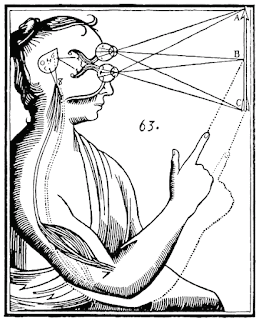 Drawing in René Descartes' (1596-1650)
Drawing in René Descartes' (1596-1650) "Treatise of Man" explaining the function of the pineal gland.
Thoughts exist. They don't exist in the material world, but they do exist somewhere. Thoughts are real. Thoughts are.
And what about feelings? Feelings are not the same as thoughts. You can feel happy without thinking of happiness. You can feel happy without thinking about being happy, or about whether the happiness is warranted, or about where the feeling of happiness comes from. Feelings don’t exist in the material world. But they do exist. Feelings are real. Feelings are. It’s unclear whether feelings exist in the same world as thoughts, or in another, non-material world.
Emotions: are they the same as feelings? Are emotions thoughts? Where do emotions exist?
Memories: are they thoughts? Where do memories exist? Memories can be of things in the material world as well as of things in non-material worlds. Memories of dreams, for example, are memories of non-material things that exist in a non-material world. In contrast, the memory of an apple you ate for breakfast is a memory of a material thing that exists in the material world (or at least did exist until you ate it). You remember non-material things such as thoughts and dreams just as easily as you remember material things, such as apples and kings and cabbages, (as the walrus suggests).
Of course, many people (e.g. Daniel Dennett) deny there is a non-material aspect to such things as thought, memories, and consciousness. They say that consciousness, for example, doesn’t exist in its own right, as a first-order phenomenon, but rather is nothing more than electrical impulses in the brain. And it is those electrical impulses that we humans dress up in the unreal glamourous enchantment we label as “consciousness”.
They even have a word for it: “epiphenomenon”, a “secondary phenomenon that occurs alongside or in parallel to a primary phenomenon”, as Wikipedia puts it. In those terms, thought is “simply” an epiphenomenon — a footprint not a foot, a shadow not the thing that casts the shadow. Well I don’t know. But even if consciousness is “simply” a “mere” epiphenomenon, that doesn’t mean it doesn’t exist. If consciousness is an illusion, it’s a real illusion: There really is such a thing as the illusion of consciousness!
Thoughts, feelings, emotions, memories, consciousness: all of these and more can and do have effects and causes in the material world. And those effects and causes persist over time. A recipe for apple-pie, for instance, can be the (formal) cause of a material apple pie coming into being in the material world. (The baker is the efficient cause). But the recipe is an idea, a thought, a sequence of thoughts. Or, you could term it a formula, an algorithm, a series of relationships. The recipe may be captured in words on paper, or in spoken words, or in pictures and symbols. Whatever a recipe is --- a thought, an idea, an algorithm --- it exists in a non-material world irrespective of the nature of its captivity within a material substrate. Apple pie exists in the material world. A recipe for apple pie exists in a non-material world, though it may be incarnated as words printed in material ink on material paper. But, funnily enough, the words are non-material and are part of language, which likewise is non-material and exists somewhere in a non-material world.
And yes, I realise that some people would call the above “dualistic”. But so what? In fact it's more than dualistic, much more. There are more than just two worlds, two domains: material and non-material. I suspect there is an infinite number of domains.
Or, maybe, just maybe, some of these things I've called non-material exist in one or more of the teeny, tiny compactified dimensions of the string theorist's 11- or 26-dimensional reality
The implications of admitting there is more than one domain, the material domain, are hugely significant. Once you open that door, all sorts of things can rush in. If mind exists in a domain that is separate and different from the material domain, then we must seriously consider the possibility at least of other non-material things, such as soul, to give just one example.
But the many worlds that may exist, according to this post, are not the same as Everett's many worlds in the quantum physics theory of the same name, though there are interesting parallels.
HOME
eBooks by Cosmic Rapture
(for kindle, tablet, smartphone or e-reader.)
NIGHTMERRIES: THE LIGHTER SIDE OF DARKNESS. This so-called "book" will chew you up, spit you out, and leave you twitching and frothing on the carpet. More than 60 dark and feculent fictions (read ‘em and weep) copiously and grotesquely illustrated.
AWAREWOLF & OTHER CRHYMES AGAINST HUMANITY (Vot could be Verse?). We all hate poetry, right? But we might make an exception for this sick and twisted stuff. This devil's banquet of adults-only offal features more than 50 satanic sonnets, vitriolic verses and odious odes. MANIC MEMES & OTHER MINDSPACE INVADERS. A disturbing repository of quirky quotes, sayings, proverbs, maxims, ponderances, adages and aphorisms. This menagerie holds no fewer than 184 memes from eight meme-species perfectly adapted to their respective environments.MASTRESS & OTHER TWISTED TAILS. An unholy corpus of oddities, strangelings, bizarritudes and peculiaritisms, including but not limited to barbaric episodes of herring-flinging and kipper-kissing. A cacklingly bizarre read that may induce fatal hysteria. Not Recommended! FIENDS & FREAKS and serpents, dragons, devils, lobsters, anguished spirits, hungry ghosts, hell-beings, zombies, organ-grinders, anti-gods, gods and other horse-thieves you wouldn't want to meet in a dark cosmos. Immature Content! Adults Maybe.HAGS TO HAGGIS. An obnoxious folio featuring a puke of whiskey-soaked war-nags, witches, maniacs, manticores and escapegoats. Not to mention (please don't!) debottlenecking and desilofication, illustrated. Take your brain for a walk on the wild side. Leave your guts behind.
No comments
Post a Comment